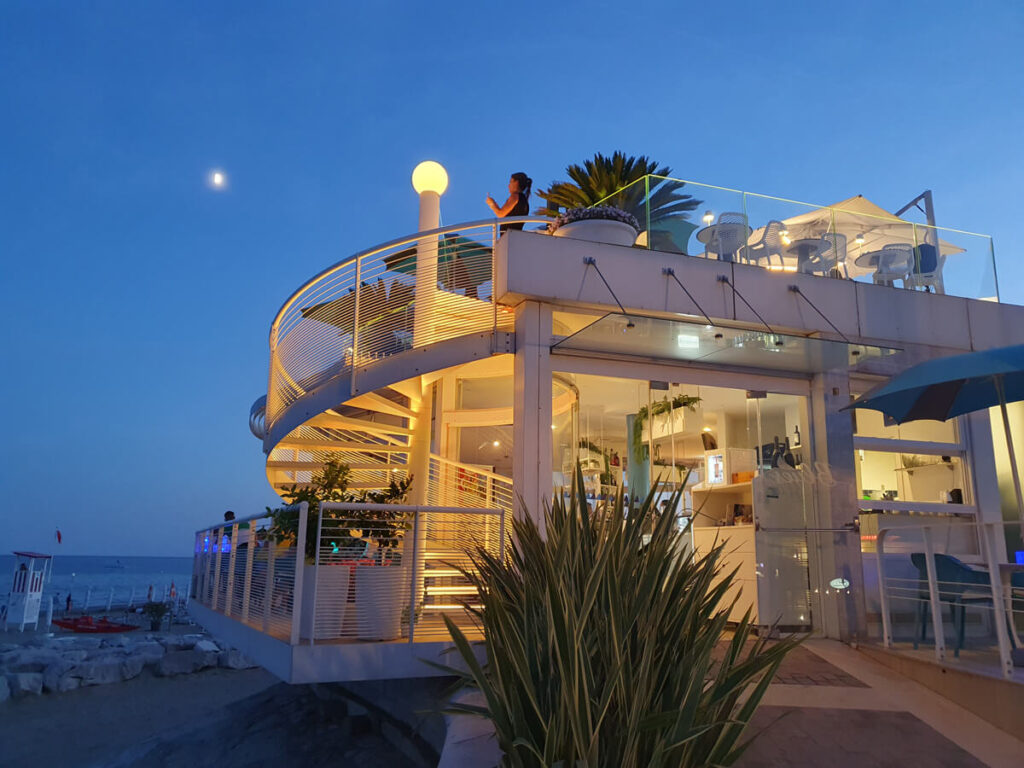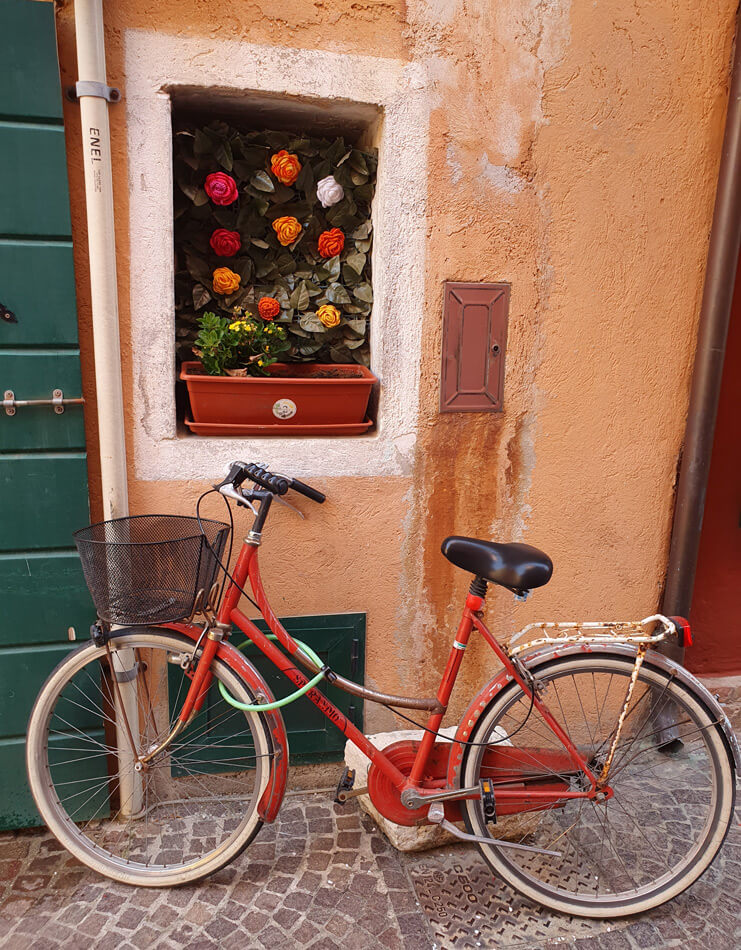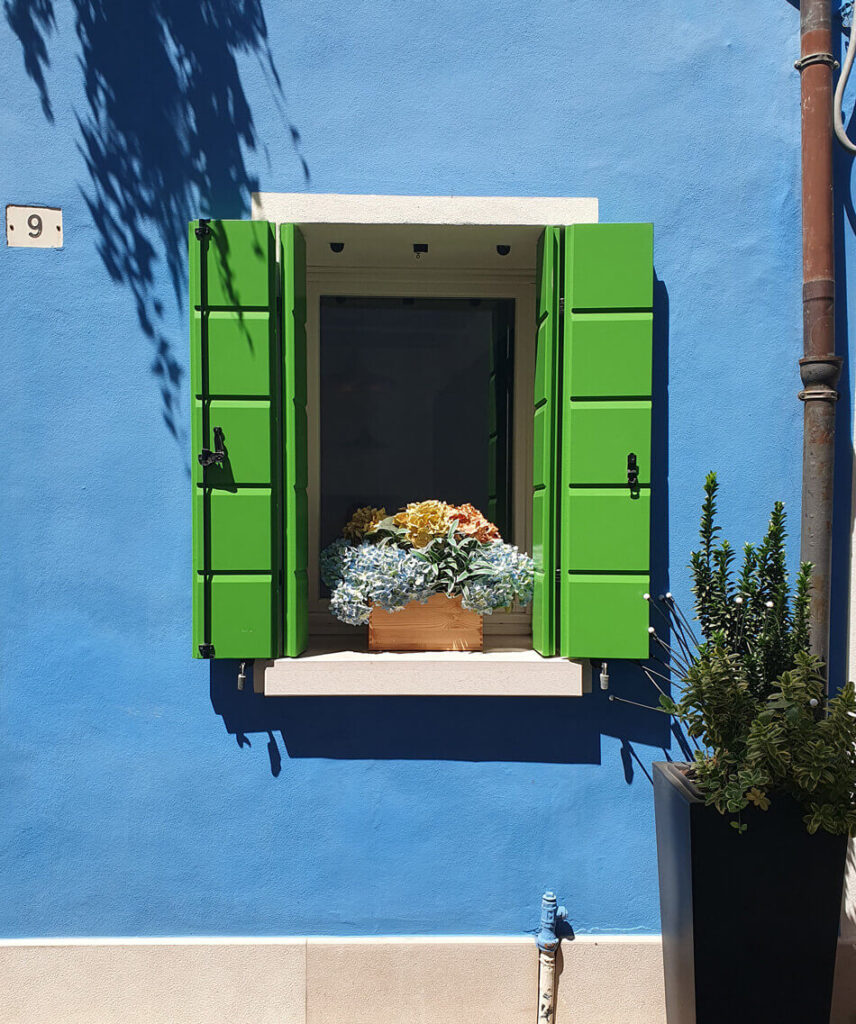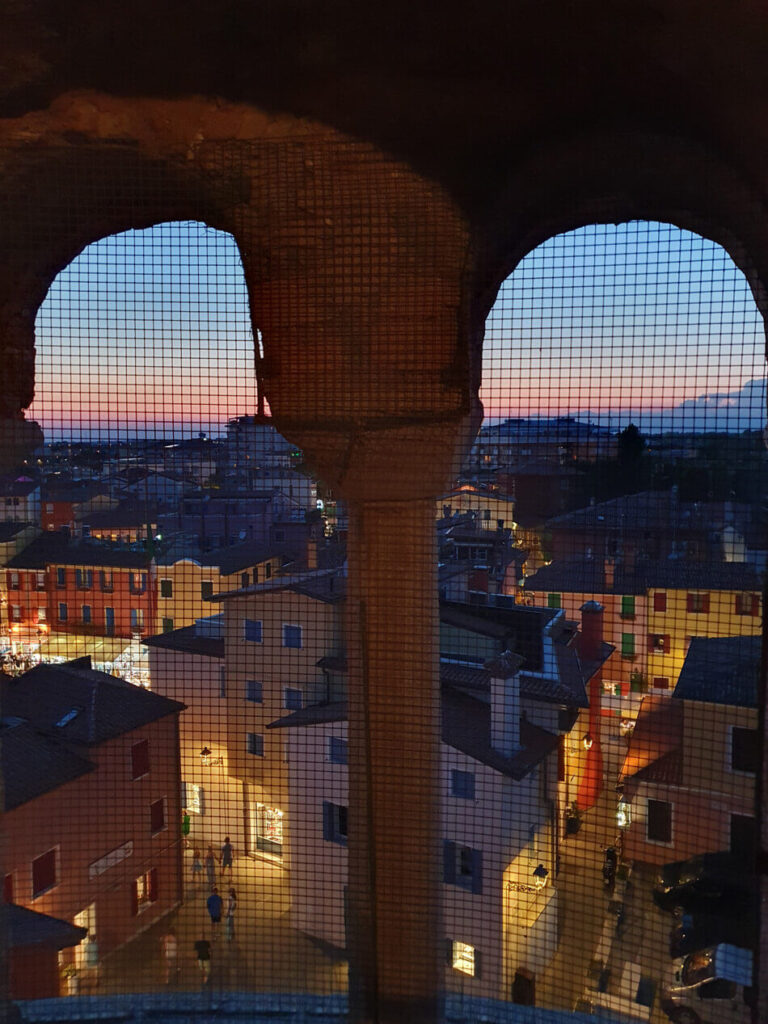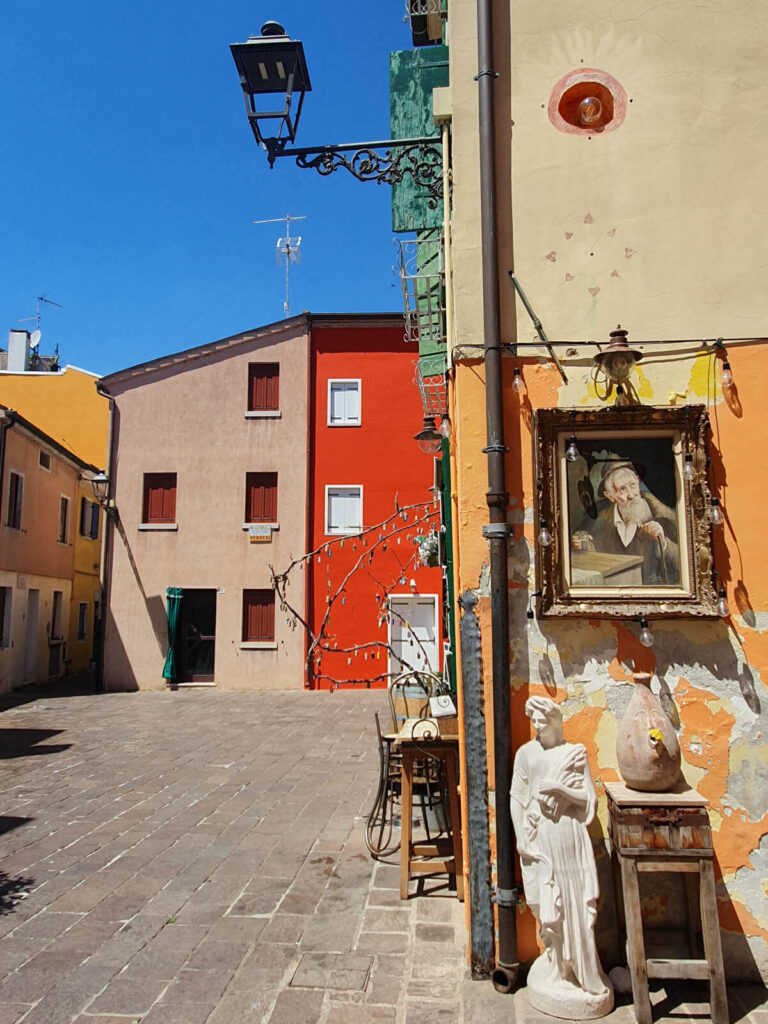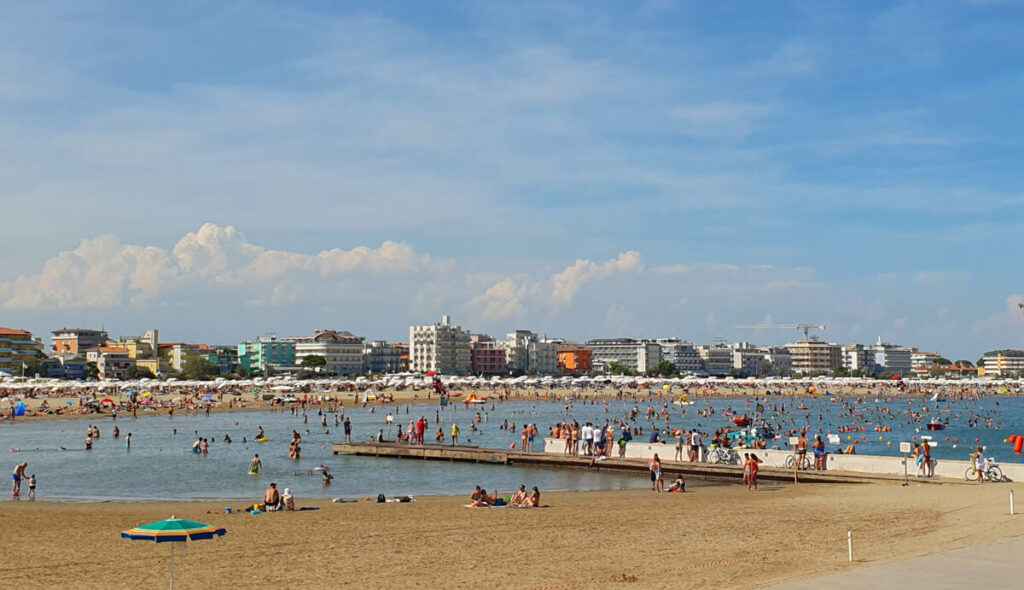About Caorle
Caorle is a popular and charming seaside resort in the Veneto region of Italy, north of Venice. It has large beaches on the Adriatic sea, a pretty and colourful historic centre, and fascinating fishing traditions which can be glimpsed on an excursion along the waterways of Caorle’s lagoon. This is a great destination for a family holiday, relaxing break or seaside stopover. I’ve really appreciated the feelgood, welcoming atmosphere when I’ve visited.
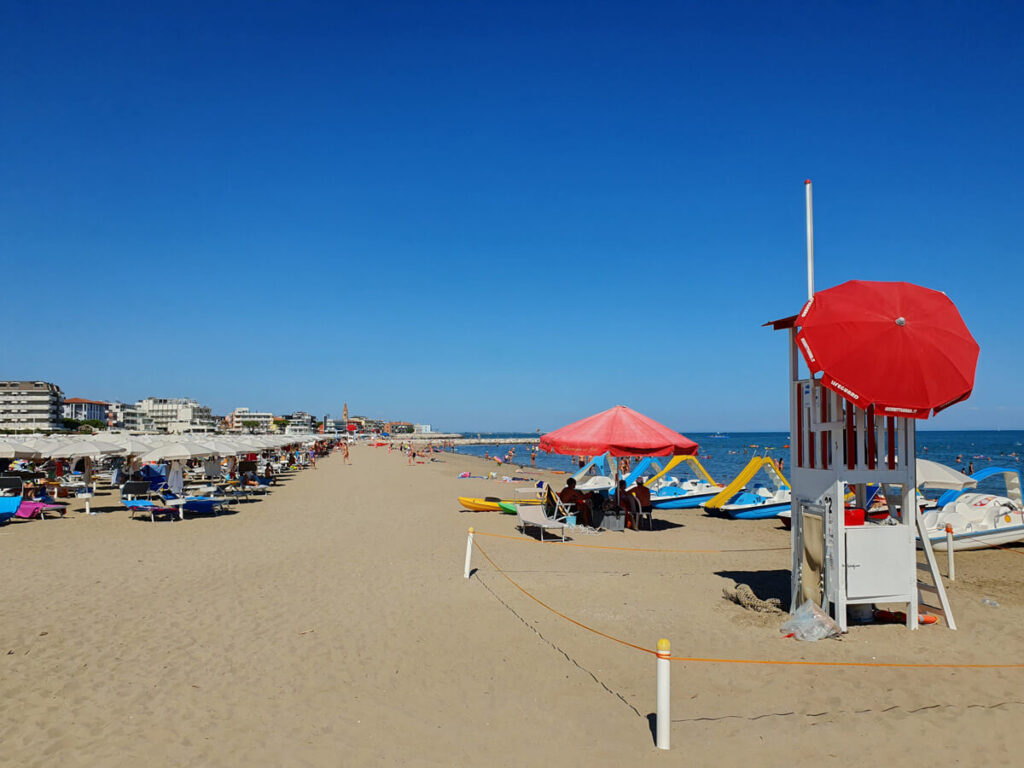
Caorle is very much geared up for summer beach tourism; this small town (population c.11,000) has hotels with beds for tens of thousands of holidaymakers. Despite its popularity, Caorle isn’t particularly well-known to English-speaking travellers. Most of the summer visitors here are Italians or from Austria, Germany and Eastern Europe. However, English is widely used in tourist businesses as a lingua franca, and German is also common.
If you prefer to avoid crowds, late spring or early summer (May-June) is the ideal time to visit Caorle. Autumn is quieter too.
Caorle is pronounced with the stress on the first of three syllables (KA-or-lay). It is not far from the modern, better-known resort Lido di Jesolo.
Find and book Caorle hotels. With location maps and guest reviews (or read on for my recommendations)
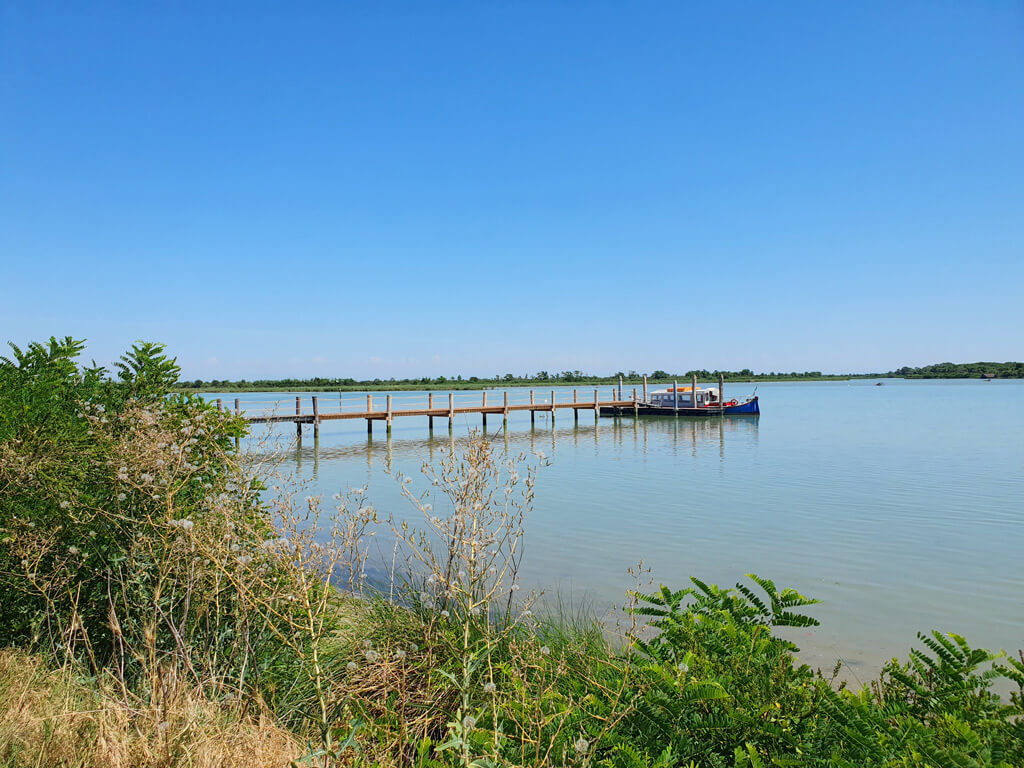
Why visit Caorle?
Caorle is an excellent choice if you want a beach holiday offering something more than sea, sand and sunloungers. The historic centre and the fishing town’s heritage add variety and a genuine Italian/Veneto feel to a holiday. Among Italy’s northern Adriatic resorts, this one of the best, in my opinion.
After enjoying the miles of sand and resort infrastructure, you can spend the evening enjoying a passeggiata through the brightly-painted centro, and dine at outdoor tables among quaint lanes and squares. The quirky colours and historic details are a photographer’s dream. Hire a bicycle and you can explore the picturesque and flat agricultural land and waterways near Caorle, or head further inland for more cultural attractions. Boat trips explore the unique waterscape close by, or take you as far as Venice for a day out.
Caorle offers more variety and cultural depth than most developed modern beach resorts, and it is also a very welcoming, safe-feeling and family-friendly destination. Many summer visitors book extended annual stays but it’s also a great place to stop for a couple of relaxing days if you’re touring this corner of north-eastern Italy by car, public transport or bicycle. Although there are a lot of hotels, I’d recommend booking well in advance, especially for the peak summer months, to get the best choice of accommodation.
Caorle’s history and geography
Before it was a holiday resort, Caorle was a fishing port, and although tourism is now the most visible business here, fishing is still important. The fishermen’s port, Porto Peschereccio, behind the town centre, is lined with working sea-going fishing boats. There’s an unusual sales tradition here when the catch is unloaded: a whispering auction. Seafood and catches from the inland waterways are a speciality you’ll find in most of the town’s restaurants, and there’s a public fish market you may want to visit if you’re self-catering or just curious.
Caorle sits between the mouth of the river Livenza, a network of inland canals (draining the formerly marshy Veneto) and a wide area of water, mud and small islands known as the Caorle lagoon (Laguna di Caorle). Surrounded by waterways, Caorle is effectively an island, though connected by bridges. Porto Santa Margherita, a seaside suburb just the other side of the Livenza, is connected to the centre of Caorle by a ferry (traghetto). Along the lagoon shore are some examples of an unusual kind of local dwelling, seasonal fishermen’s huts called casoni, made of reeds. A trip to see these is great way to spend a few hours – you can read about bike and boat excursions further down this page.
Caorle’s historic centre is clustered on a small bulging promontory, with long wide beaches either side. The town’s most significant buildings and prettiest scenery can be found here, and I write about these below. Rows of hotels line these seafronts and most of the town’s accommodation is close to the beaches.
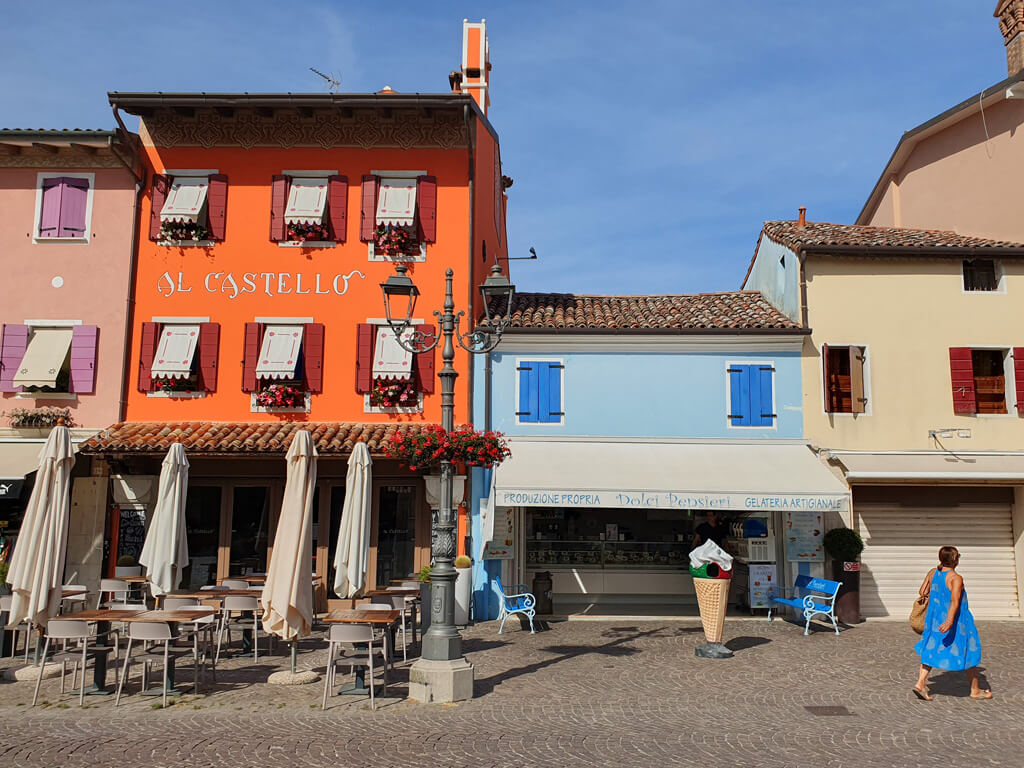
Tourist sights
Caorle doesn’t have any great tourist sights or itineraries; this is the kind of resort where visitors can concentrate on the important holiday activities of strolling, relaxing on the beach and whiling away the time at café tables. That’s not to say that Caorle is a bland modern resort, though. The historic centre, just behind the seafront, is charming and full of character, with colourful painted houses and picturesque little squares and alleyways. And there are a few sights you certainly shouldn’t miss.
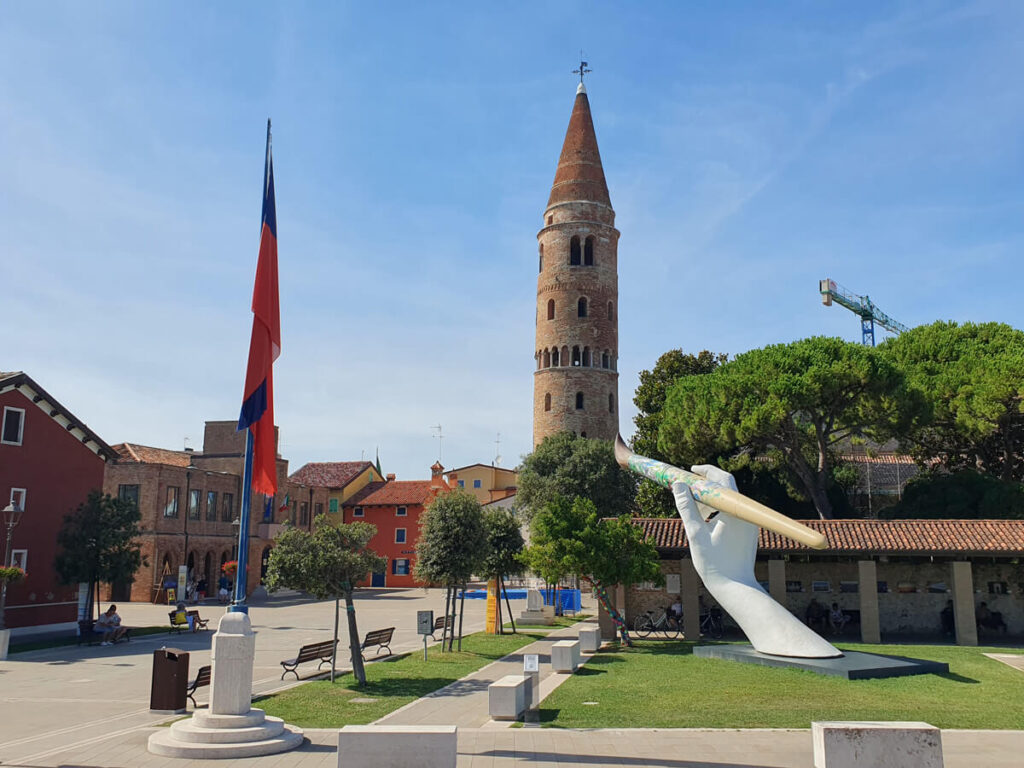
The emblem of Caorle and its most characteristic and famous sight is the cyclindrical belltower (Campanile) which rises above the historic centre in front of the cathedral. This tall round tower was possibly built as a watchtower; the views from the top must be tremendous. The upper part of the tower seems to be supported miraculously by a fine, delicate arched loggia. The campanile is sometimes open to the public and for a fee you can climb the narrow and steep steps inside (check seasonal times locally; when I visited in summer the opening time was 9pm). On two evenings each July the campanile is ‘set on fire’ as part of a religious celebration (more below).
The heart of town is Piazza Vescovado, site of the town’s cathedral, the Duomo or Cattedrale di Santo Stefano as well as the campanile. The cathedral is a fine ancient building dating from the eleventh century, though heavily restored. Inside the church is a calm aura of antiquity. Stone and brick columns alternate either side of the nave, and a fragment of early-Christian sculpted marble is incorporated into the modern pulpit. Don’t miss the rather endearing fresco of Santa Lucia, presenting her eyes on a plate, surrounded by quaintly-painted scenes from the saint’s life. An equally charming wooden statue of San Rocco stands near the door, proudly displaying his own saintly attributes of a plague sore on the thigh and a little dog. The cathedral’s other precious art includes a fifteenth-century wooden crucifix and a ‘Pala d’Oro’ screen of silver and gold displayed behind the altar.
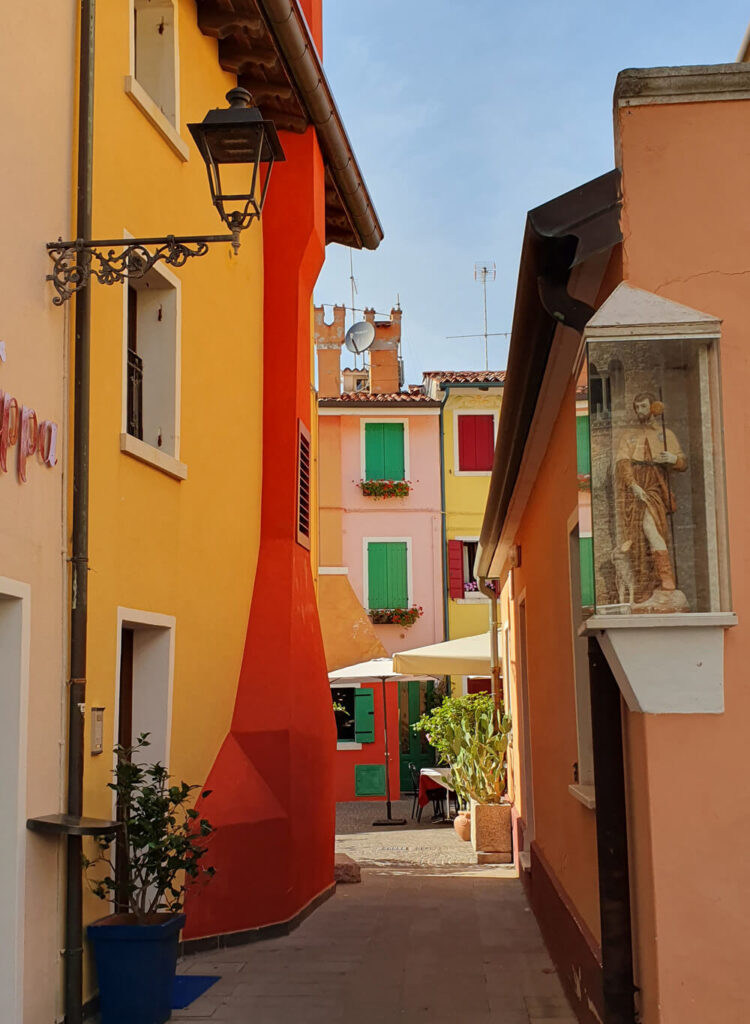
As well as its historic cathedral, Caorle has another, even more photogenic church. The eighteenth-century Santuario della Madonna dell’Angelo sits right on the tip of the promontory with a campanile that doubles as a lighthouse, looking masterfully out over the Adriatic and seeming to hover between the sea and the fishing boats, the lines of beach sunloungers and row of hotels along the beach beyond. The church commemorates a miracle; when a statue of the Virgin Mary (the Madonna dell’Angelo) was said to have been found by local fishermen as it floated miraculously in the sea on top of a block of marble, still displayed in the church. The earlier statue of the Madonna was lost in a fire but a replacement is venerated in its stead. On the ceiling of the church a painting depicts the miraculous events.
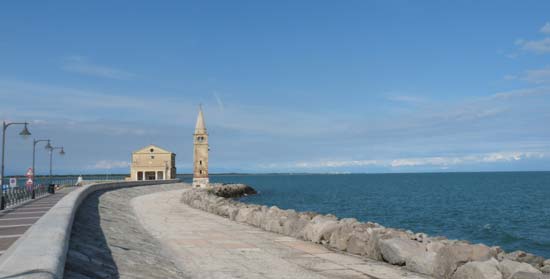
The Madonna dell’Angelo, her church and the story are important to the caorlotti, people of Caorle. Every five years on the second Sunday in September there is a big religious celebration remembering the miracle, with a waterborne procession.
There is also an annual celebration of the Madonna dell’Angelo on the second weekend in July; on a smaller scale but still a significant event, and one that it’s really worth timing your visit to witness if you can. Each year on the Saturday the statue of the Madonna is carried in procession from the waterfront Santuario to the Duomo. Masses are held and prayers said. The following evening, after a special mass, another procession carries the statue back to its home in the Santuario. Both occasions involve solemn processions with crowds attending. When the Madonna is outside the Duomo, fireworks are let off inside the Campanile in a famous spectacle known as the Incendio del Campanile. The red fireworks make it look as though the belltower is on fire and burning from the inside; a truly dramatic sight which I felt lucky to see.
The promenade approaching the church, the Lungomare Petronia, is separated from the sea by boulders which have been sculpted by artists into a permanent art show.
There is a central shopping street, Via Rio Terrà (a former canal), which is largely pedestrianised, where you can find everyday shops as well as beachwear, postcards and ice creams. Hidden away in little courtyards are pretty cafes and restaurants; glancing through gaps in brightly-painted houses you’ll see comfortable scenes such as couples eating at a pizzeria, comfortable outdoor bar tables under vine-covered trellises, a local leaning a bicycle against a painted wall.
The historic centre and seafront promenade are lovely places to stroll, or sit and rest with a drink or ice cream. There’s a good choice of places to do this; although it can be hard choosing between the charm of the inland streets, and a balcony seat overlooking the sea.
Things to do
Caorle is a seaside resort, so for many visitors, the main thing to do is to enjoy the beaches and the sea. This, along with pottering around the centre, is the principal activity of Caorle. However, if you are feeling active, there is more to do. To explore further afield, it’s a nice idea to hire bicycles – the area is very level, with some good cycle paths and interesting routes. There is more information below on cycling around Caorle.
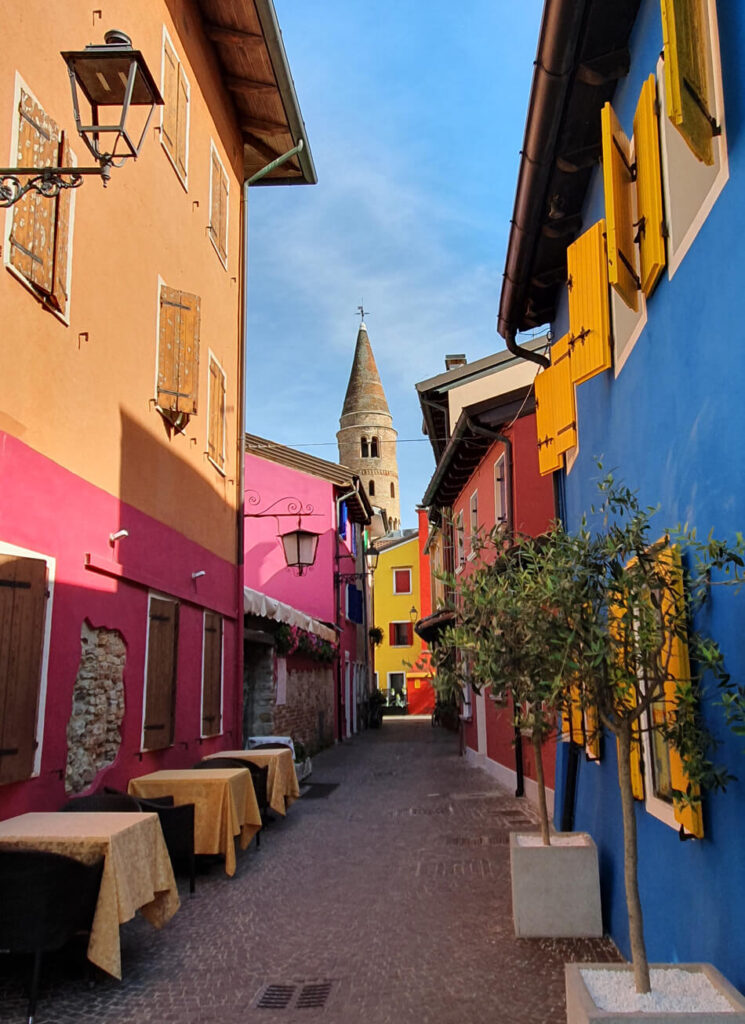
If you have small children, or aren’t keen on the effort of cycling, you could catch a little tourist train which runs about the town in the morning and the evening. At the time of writing this departs from the roundabout in the town centre, Piazza Papa Giovanni. Once a day this little train trundles as far as the fishermen’s casoni.
Inland, behind the bus station, are family attractions; the Lunapark and a water park. Adventurous travellers can also hire boats or go on diving excursions. There’s an 18-hole golf-course, Golf Pra’ delle Torri, five miles away beside the sea.
If you are spending more than a couple of days in the area, I’d recommend visiting inland Portogruaro and Concordia Sagittaria, easily reachable by bus or bike – and by occasional ferries in the summer. Portogruaro is a pretty historic town with fine scenery and an archaeological museum, and Concordia Sagittaria offers a historic church above a fascinating archaeological site.
Caorle beaches
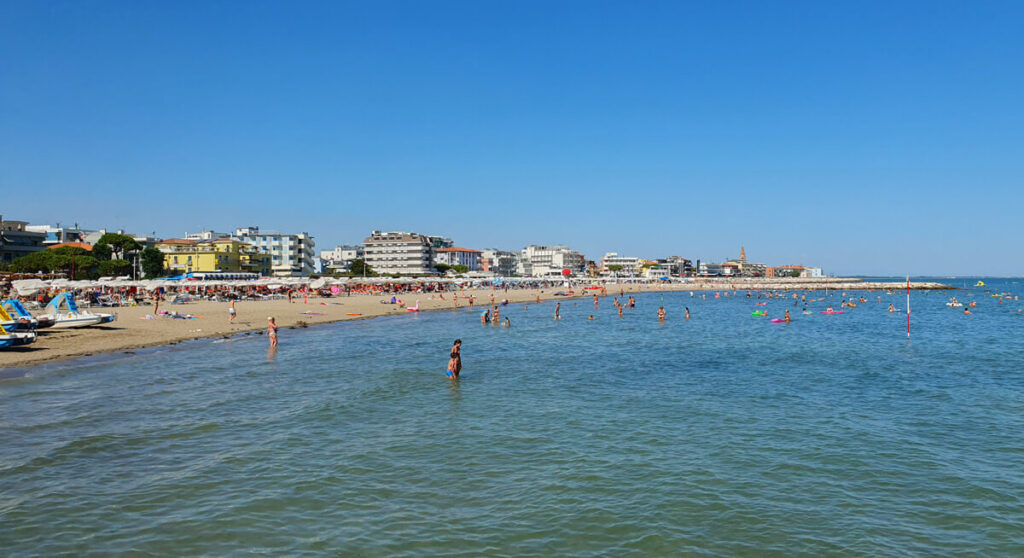
There are wide sandy beaches on either side of the historic centre of Caorle, linked by a charming seafront promenade which skirts the centre. The sand is fine and kept relatively clean (by Italian standards; bear in mind there is little tide here to scour the beaches). The beaches slope very gradually into shallow water, so feel safe and pleasant to enjoy for everyone including small children and non-swimmers. In my experience the water of this whole northern end of the Adriatic can be a bit murky and contain a lot of seaweed, but that’s very dependent on season, currents, winds and tides and not unique to Caorle. With pedalos to rent, lifeguard stations and swimming platforms, the waters here offer a lot of fun and the ideal environment to cool off on a baking summer’s day.
The long wide stretch of beach to the north-east of Caorle’s town centre is called the Spiaggia di Levante (Eastern Beach) and that to the south-west is the Spiaggia di Ponente (Western Beach). Visitors may have a preference, but I wouldn’t say one is particularly better than the other. The eastern beach is wider with more contemporary new hotel developments behind it, across a road, while the western beach has more 20th-century buildings and the sea is closer, with a pedestrian promenade between the beach and hotels. I stayed by the Spiaggia di Ponente and enjoyed it, along with the possibility to stroll along the seafront promenade into the centre. However when I cycled along the Spiaggia di Levante, the long wide stretches of sand, especially at the more untouched end towards the lagoon, were also tempting.
Caorle’s beaches are very well-equipped, lined with row upon row of sunloungers and parasols for hire. There are children’s play areas on the sands, and also fitness areas. Behind the beaches are a few streets of hotels and holiday rental apartments, along with all the normal seaside businesses: gelaterie, cafés, bars, restaurants, and shops selling beach equipment, holiday clothing and souvenirs. The town doesn’t extend far inland from the sea, so wherever you are in Caorle, the beach is never far away.
Enjoying the comfort and services of a paying beach lido is part of the traditional Italian beach experience, and I always find this an excellent and civilised way to get the most from time by the sand and sea. With a sea breeze, parasol (ombrellone) for shade and sunloungers (lettini) for comfort, you can while away comfortable hours on hot days.
There’s a huge choice of paying beach establishments, along the beaches, in numbered stretches, along with freely accessible showers and beach bars. There are even, at the time of writing, beaches especially for pet owners. Bau Beach to the north-east of town is an equipped beach in lots of space which welcomes dogs, and another pet-friendly area is at the far end of the Spiaggia di Ponente.
A place at a beach may be included in your hotel room rate or bookable through your accommodation at a discount – I’d start there when looking to decide what beach to choose. Note that sometimes in Italy the cost of sunbeds is reduced later in the afternoon (typically after 3pm).
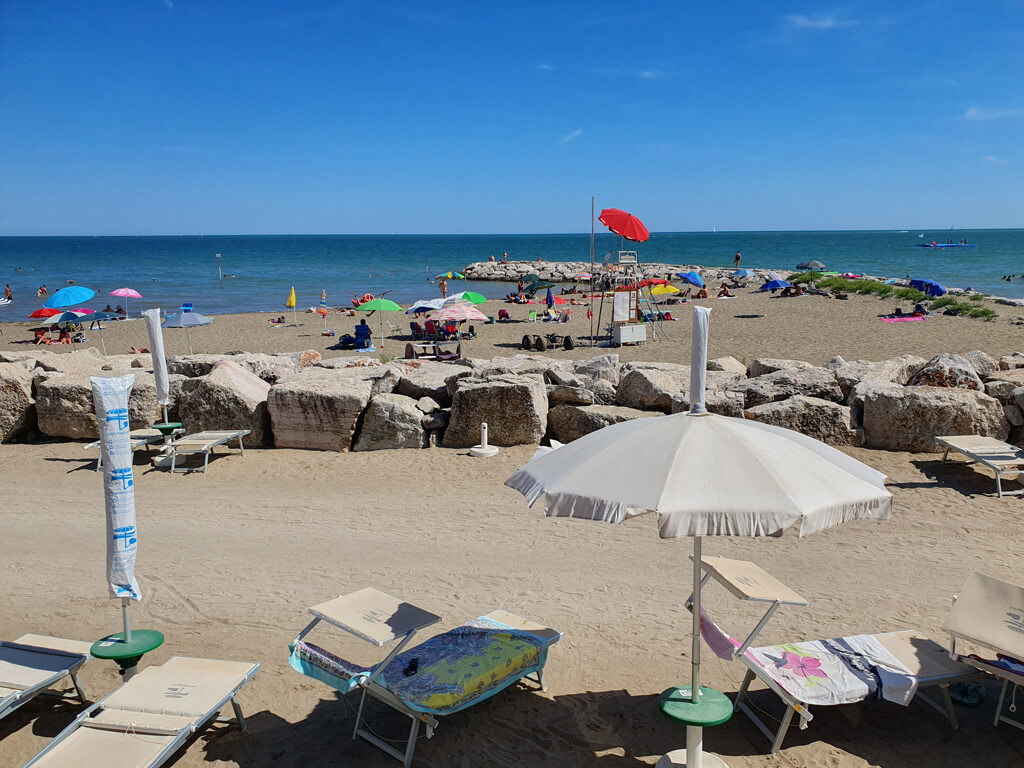
If you don’t want to pay or only want a short spell on the beach, head to a free beach, spiaggia libera, with your towels. Again, your accommodation/host can probably advise on the nearest and best based on where you’re staying. Some non-paying beach users will position themselves near the stone breakwaters or between the waterline and rows of sunbeds, though this isn’t always happily permitted by businesses. There are, though, pleasant stretches of free beach in Caorle, including, at the time of writing, a cove close to the historic centre by Lungomare Petronia, and the first curve of sand on the Spiaggia di Levante, alongside the town centre.
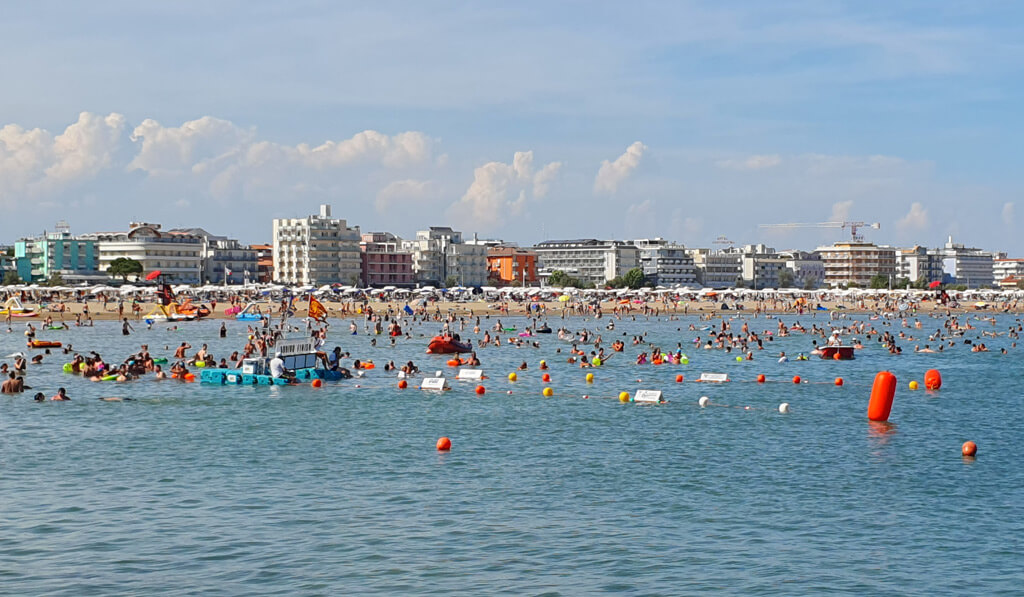
Boat trips
If you are visiting Caorle in the summer months, a boat excursion is a must-do activity. Daily trips take holidaymakers into Venice, but you shouldn’t miss the opportunity to explore the waterways and lagoon of Caorle itself. Two or three boats, including a small traditional bragozzo, operate trips lasting a couple of hours which explore the waterways and lagoon of Caorle. There are also romantic evening boat trips.
Boat trips start running regularly around the middle of May, but it is always a good idea to check and perhaps book in advance, by telephoning ahead, or asking your hotel or the tourist office. Trips to Venice run Monday-Friday, departing at in the early morning and leaving Venice during the afternoon.
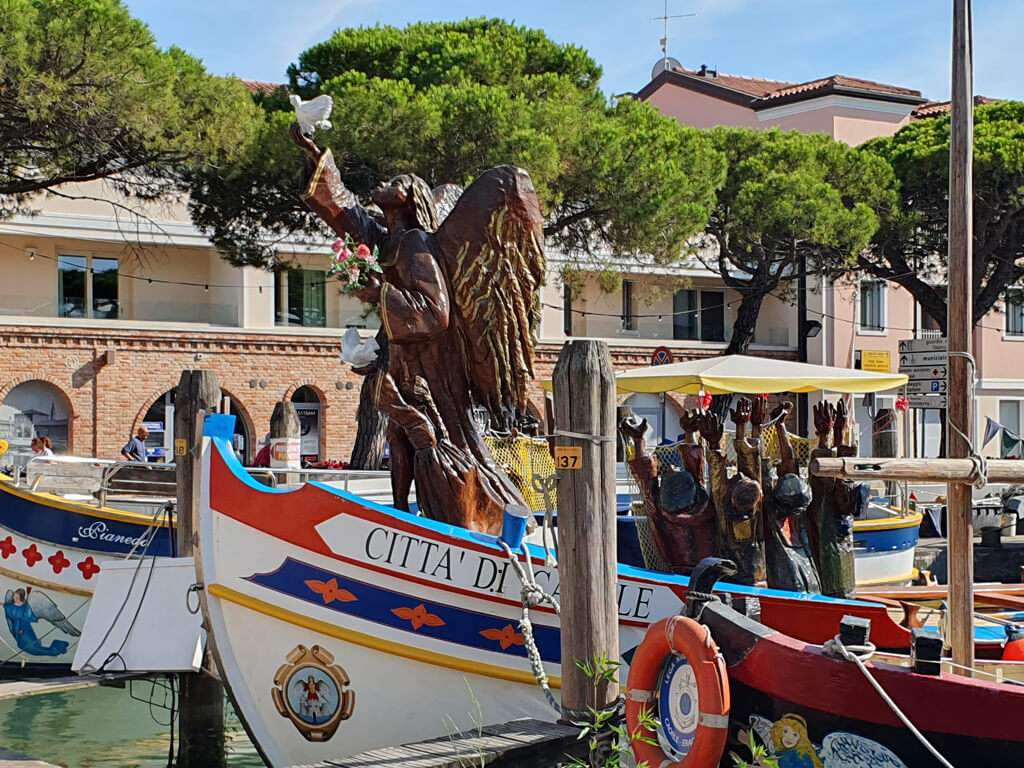
Cycling
There are a number of different bicycle itineraries in and around Caorle; ask at the tourist information office or your hotel for more information – or plan your own route on a map. On the map below I’ve marked the cycle route I followed to see the casoni by the lagoon. The landscape is flat and divided by canals which frequently have paths alongside them, so it is a good area for cycling. Although not dramatic, the rural scenery is attractive and interesting. In Caorle you can hire bicycles (normal bikes as well as the multi-rider ‘jaunting’ kind) on Via Istria, at a reasonable hourly rate. I’d suggest taking sunscreen and water as well as, perhaps, a picnic on your excursion.
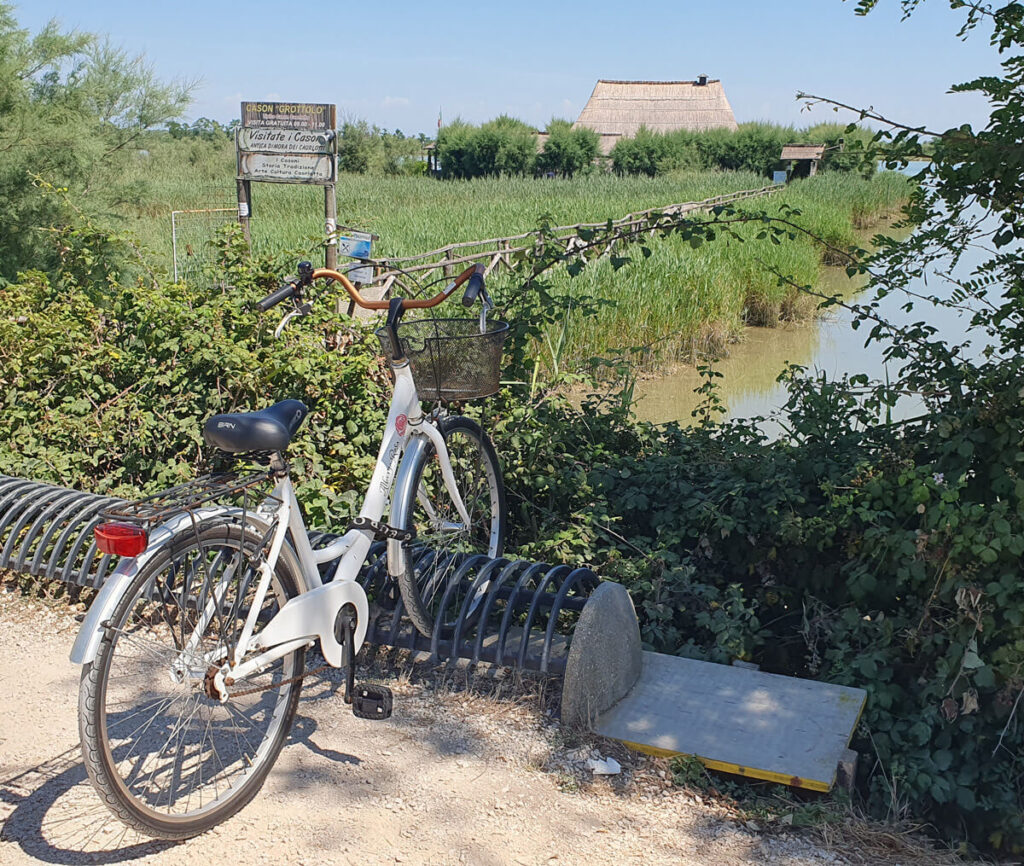
The fishermen’s casoni of Caorle
Even if you are only visiting Caorle for one day, I’d recommend you make the effort to discover some of the Veneto’s unique traditions, and visit the truly atmospheric fishermen’s settlement on the lagoon shore. Just a couple of miles outside the lively tourist centre of Caorle, you find yourself in a peaceful green spot alongside the lapping water, where time seems to be standing still. Here, fishermen who worked in the lagoon built houses (casoni) made of reeds and rushes which served as bases for their fishing expeditions. These unusual buildings are like tall thatched cottages with high pointed roofs. Inside there is usually a central fireplace for cooking the catch, and long tables where groups of friends (‘friends, not family’ I was told) come to enjoy long convivial fish suppers. Boats are moored alongside in their own little shelters, and several of the casoni have little vegetable patches alongside.
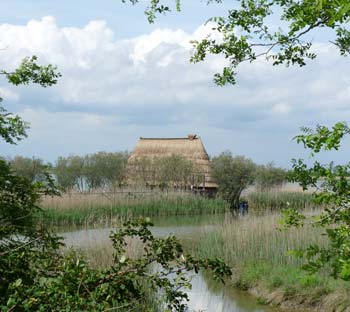
Although this traditional way of living and working may be dying out, there are still fishermen who maintain their traditional casone and spend time by the lagoon every day. Tourists can visit the casoni on boat trips from Caorle, or on the once-daily extended tour of the little tourist train. These modes of visiting, of course, have the disadvantage that you’ll be with a group of other visitors. Walking or cycling to the lagoon allows for a more leisurely and atmospheric visit. There is a cycle and footpath along the lagoon shore (see map below) which passes by a number of picturesque fishermen’s huts, some smartened up like holiday homes and one or two falling into sad disrepair. As well as the casoni, walkers and cyclists can admire the vegetation, scenery and birdlife of the lagoon. I saw huge numbers of swans as well as wading birds. Where the footpath reaches another canal, and a road, there is a car parking space and a cycle rack. From here a pedestrian footpath hugs the shore and crosses a long bridge to the Isola dei Pescatori, ‘fishermen’s island’, a tiny ‘village’ made up of casoni, decorated with painted entrances and kept in good repair. If you are lucky, you may be invited to see inside one of the buildings; the local fishermen are proud of their traditions and may welcome your interest.
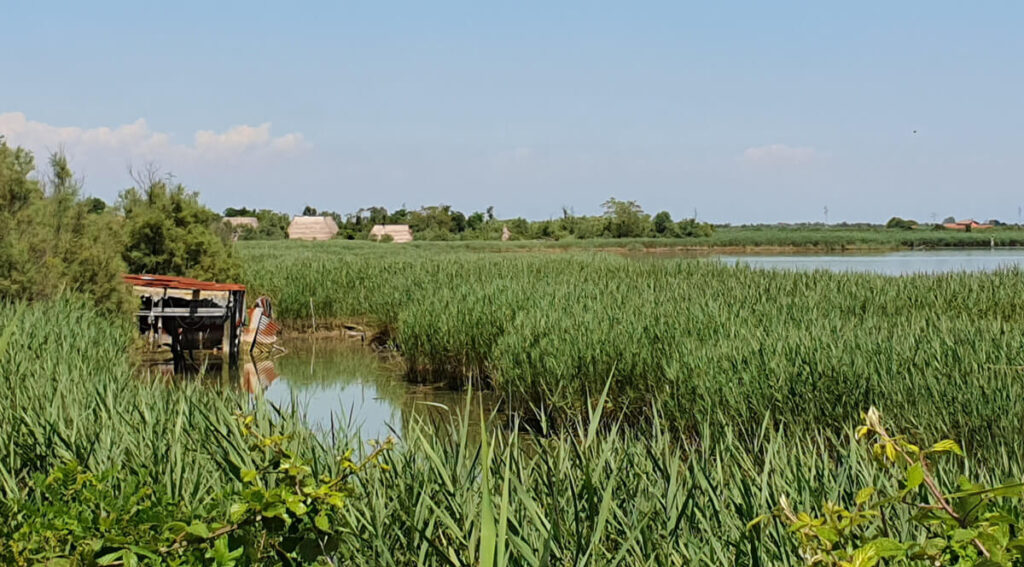
You can return to Caorle following the recommended cycle itinerary along the canalside road, or by retracing your route along the lagoon. If you choose the latter option, note that the roads leading out of Caorle are part of a one-way system and you’ll be cycling into any traffic (generally very little). A pleasant leisurely cycle ride can be accomplished in under a couple of hours, including a wander around the casoni. You could probably manage to make the tour in an hour.
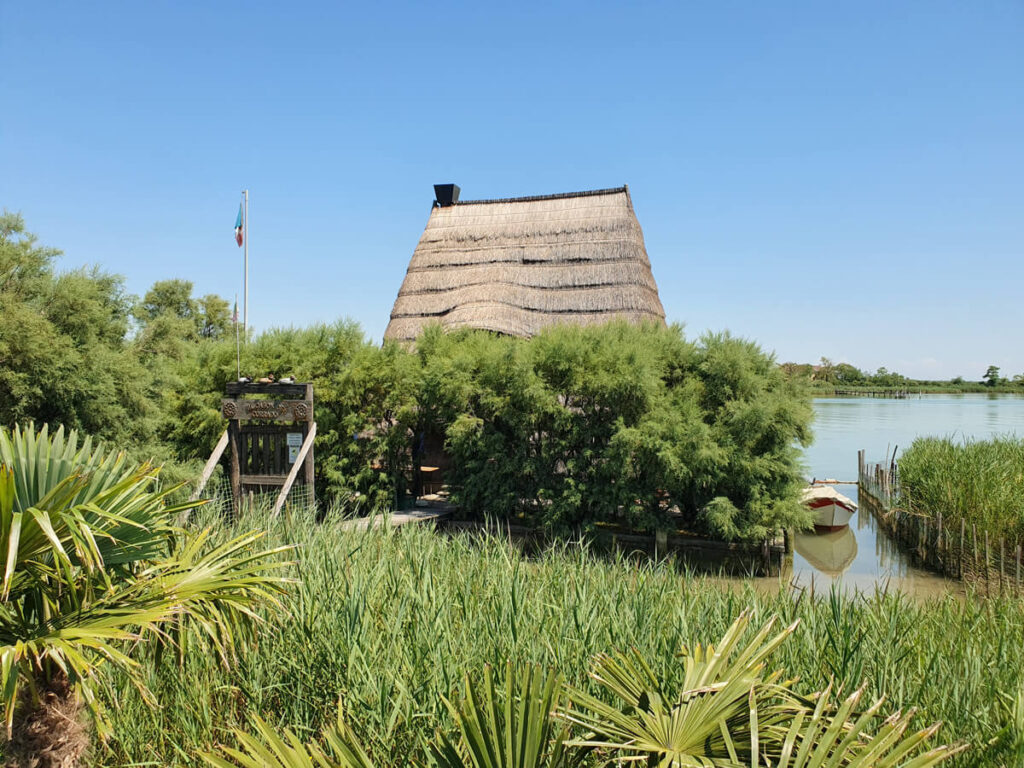
Getting to Caorle
Getting to Caorle is straightforward, thanks to regular bus connections with Venice and its airport. However, Caorle’s geographical position out on a coastline interrupted by rivers, canals and lagoons prevents it from being a good base for an exploring holiday. You can visit one or two places by public transport or driving, but if you want to take in a larger variety of destinations, I’d recommend moving on from Caorle to an inland hub like the town of Treviso.
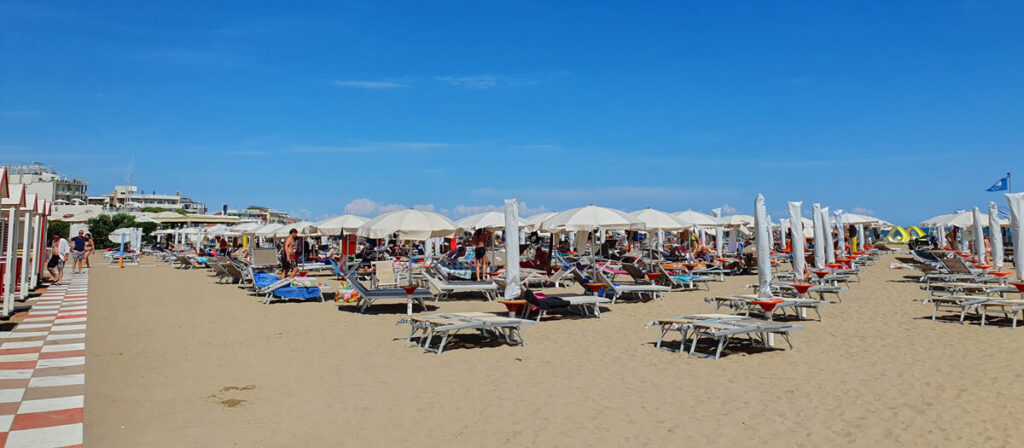
By air: The main airport for Venice, Marco Polo Airport, is very convenient for Caorle, as the ATVO bus from Venice to Caorle (see below) stops in the airport forecourt (buy your ticket in advance at the ticket desk inside the arrivals hall). The buses run roughly hourly, and the journey takes just under an hour and a half. There’s luggage space in the hold.
Treviso Airport, served by Ryanair (as ‘Venice Treviso’), is also near Caorle. A third option, also with budget flights, is Trieste Airport. From here you would need to take a bus to Monfalcone station, a train to Portogruaro and then another bus to Caorle.
By train: Caorle doesn’t have a railway station, although the station in nearby Portogruaro is named Portogruaro-Caorle. This station is on the Venice – Trieste railway line, and has an ATVO bus station outside it. Hourly buses connect Portogruaro station with Caorle; at the time of writing you can buy a joint train-and-bus ticket – put in Caorle as your destination: https://www.trenitalia.com/.
If you are keen to see more sights while visiting Caorle, you could take an early bus to Portogruaro and then use the train to visit destinations such as Venice, Trieste or Aquileia – but do check the latest timetables first. Portogruaro itself is a lovely town, and well worth visiting, and I’d recommend art/history lovers pay a visit to Concordia Sagittaria, on the Portogruaro-Caorle bus route, too.
By bus: Caorle bus station (autostazione) is a short walk from the centre of town (see my map below). ATVO services connect Caorle and neighbouring Porto Santa Margherita with the rest of the Veneto and with the railway network. You can view the latest timetables on the ATVO website (see links panel on the right). Venice is two hours away by bus; a long but scenic journey over the reclaimed wetlands of the Veneto plain. The bus stops in Piazzale Roma in Venice, and after reaching Caorle it continues over the canal to Porto Santa Margherita.
Other destinations which can be reached by bus from Caorle, although with limited journeys per day, include Treviso and Oderzo (changing at San Dona’ di Piave, a bustling inland town), the seaside resort of Eraclea Mare and Udine (a couple of services a day, changing in Portogruaro).
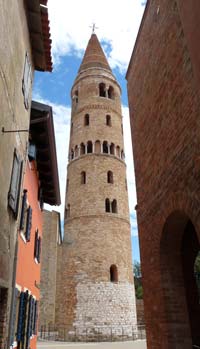
A day trip from Caorle to Venice (and vice versa)
In the summer season there are boat trips to Venice from Caorle. If you prefer to make the trip independently, the ATVO bus is the most simple way to travel between Caorle and Venice. Although the total travelling time, there and back, will be four hours, it is a reasonably comfortable and scenic journey and this is a feasible option for a day trip. You should check the ATVO timetables when planning your trip as there are some gaps between their services, and variations on Sundays and public holidays (festivi). Note the time of the last bus back, which is generally between 6pm and 7pm.
I visited Caorle as a day trip from Venice, and had time for a very enjoyable day out. In Venice you can buy bus tickets at the ATVO office in Piazzale Roma. The bus was scheduled to depart from bay B16, but went from the neighbouring space, so I’d advise keeping alert or asking a driver.
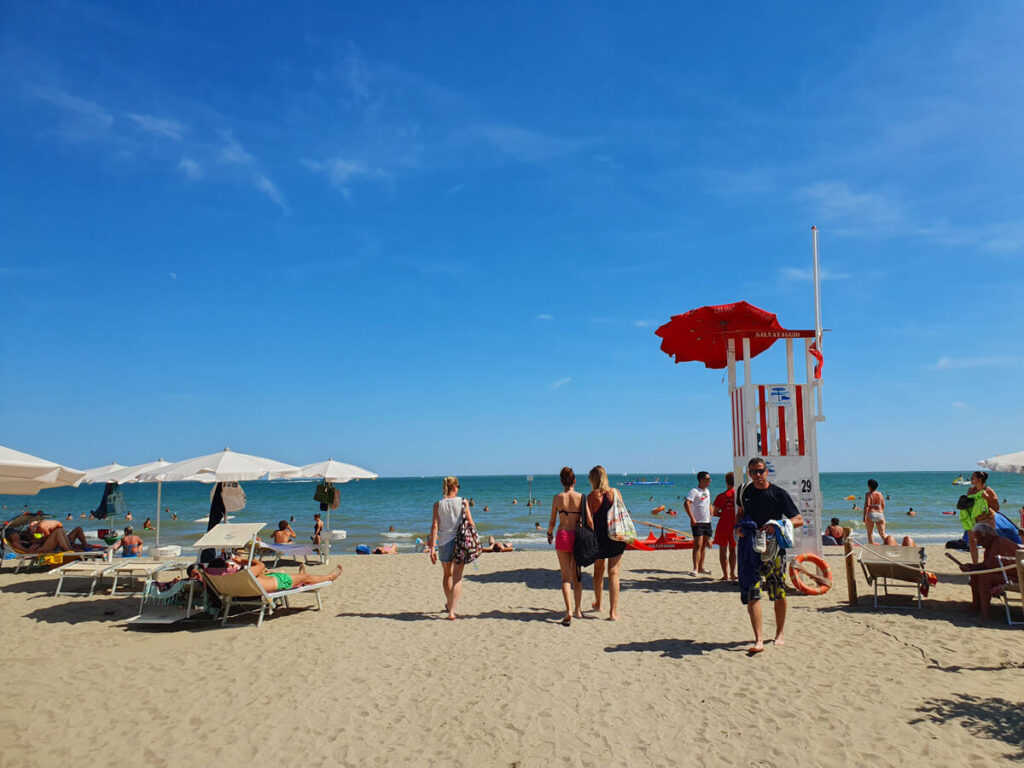
Eating and drinking
There are LOADS of eating and drinking options in Caorle, as you’d expect from a busy seaside resort. These range from contemporary-styled bistro-and-cocktail bars on the seafront to cosy and traditional family-run restaurants in the historic lanes. Gelaterie are dotted through the town, so it’s easy to find cooling refreshment when the summer heat is baking. And although sit-down meals in restaurants aren’t particularly cheap, there are also lighter options and take-aways for holiday-makers on a budget.
Some of my recommendations are below, but as there can be a fast turnover of businesses in resorts and opening times will vary, do check online before you go.

I particularly enjoyed the delicious flavours of gelato and granita (ice drinks) at the high-quality Laguna Beach gelateria just below the sea wall in the town centre, which caters to the late-afternoon and evening crowd. Dolci Pensieri, in the historic centre, is another good destination for a tempting choice of gelati.
Caorle accommodation
Caorle is packed with seaside hotels as well as holiday apartments. Several of the apartments are located right in the historic centre, so could be a good option for travellers visiting out of season, wanting the Centro Storico atmosphere or just looking for more independence. As Caorle is a very popular resort with repeat visitors, accommodation does get booked up a long time in advance so I’d recommend planning well ahead if possible. Booking a short-notice stay in July, I found that choices were very limited and that of the remaining hotels available, some had a minimum stay of two nights or more.
For a beachfront stay, Caorle offers a good range of options including the smart, modern Hotel Lux. With sea views from its rooftop pool terrace, the hotel/apartments of THE ONE CAORLE offers accommodation with a luxury feel. You’ll find a full range of choices in town from traditional budget hotels to luxury, home-like apartments and even mobile homes on campsites. Outside Caorle, drivers may consider staying at an agriturismo or rural villa for a stay that’s closer to nature. Note that not all hotels in town have their own parking, so check this when you book.
I stayed at Hotel Rosa Caorle, a simple but comfortable and welcoming 2-star hotel a minute’s walk from the sea. My room price included a sunlounger and parasol on the beach and also use of a bicycle; check what’s included when you pick a hotel as these were handy extras that saved me additional expenses.
> Caorle hotels, B&Bs and apartments (my affiliate link – thank you for your support)
Map of Caorle
View Caorle in a larger map
If you like Caorle, you may like
Grado, Friuli-Venezia Giulia
Chioggia, Veneto
Scilla, Calabria
Useful external links
Motonave Arcobaleno – lagoon boat tours
Motonave Caorle – day trips to Venice
Motonave Costa Adriatica – boat trips to Venice & lagoon
Da Fiammetta Car and bicycle rental
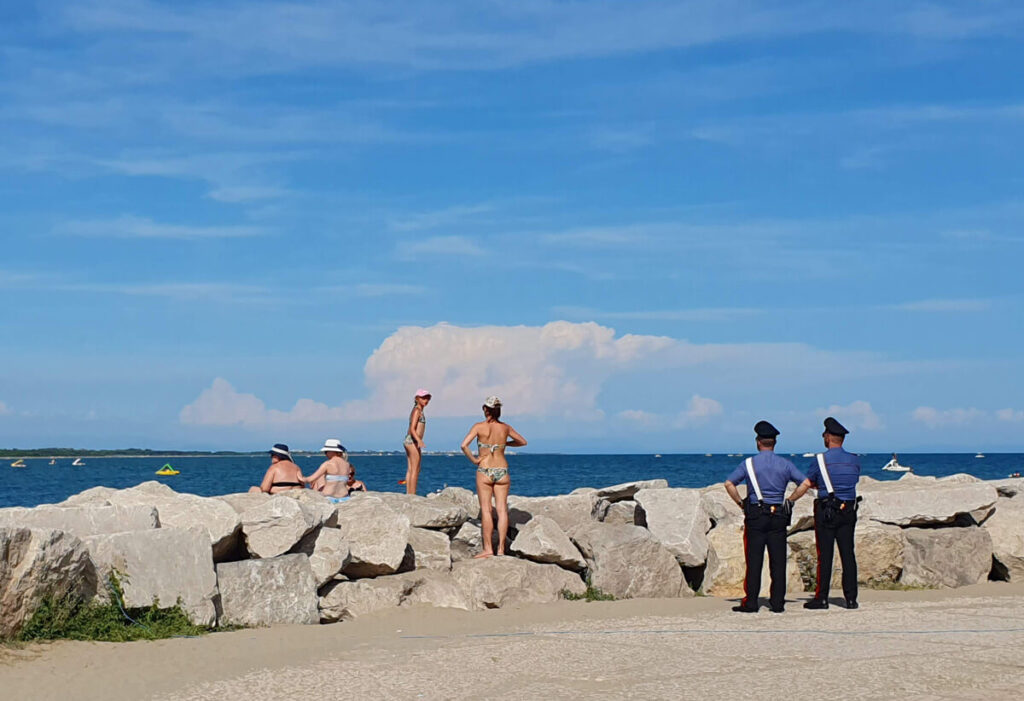
Veneto destinations
- Veneto region
- Abano Terme
- Asolo
- Bassano del Grappa
- Brenta Canal
- Caorle
- Castelfranco Veneto
- Chioggia
- Cittadella
- Concordia Sagittaria
- Conegliano
- Cortina d’Ampezzo
- Lido di Jesolo
- Malcesine
- Marostica
- Monselice
- Montegrotto Terme
- Padua
- Portogruaro
- Rovigo
- Sottomarina
- Treviso
- Venetian Lagoon
- Venice
- Verona
- Vicenza
- Veneto art & architecture itinerary
- Veneto villas – Vicenza: La Rotonda & Villa Valmarana ai Nani
- Veneto villas – Villa Pisani & Villa Foscarini Rossi, Strà
- Venice Airport
- Treviso Airport
